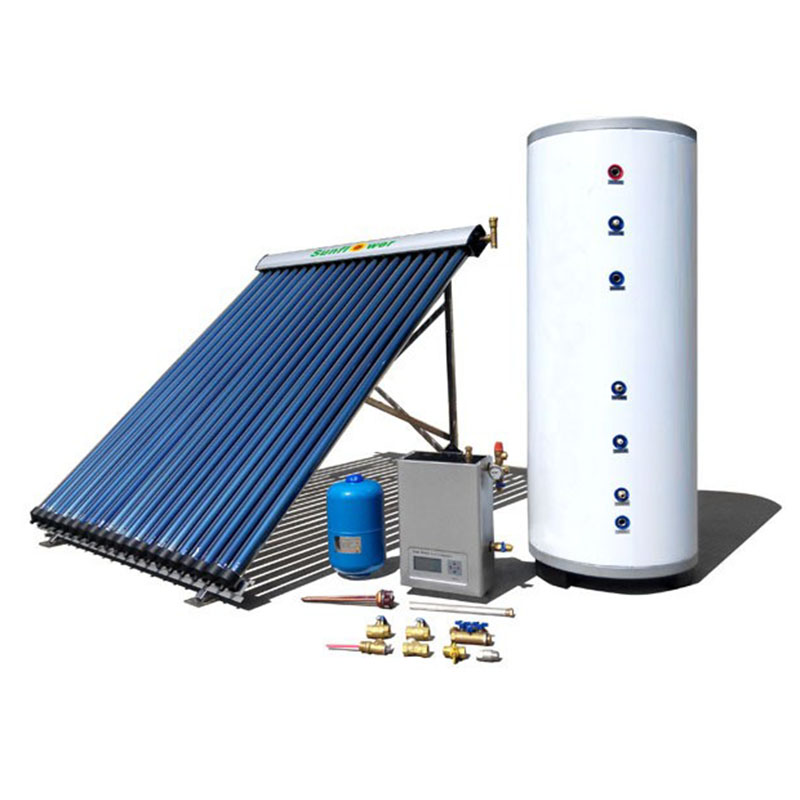Views: 187 Author: Site Editor Publish Time: 2022-04-25 Origin: Site

A solar water heating system generally consists of the following components: solar thermal collectors, a water storage tank, a circulation system with a circulator pump and a temperature controller, and a back-up gas or electric booster. In an indirect solar water heater system, an extra heat exchanger is needed, as well as an additional drainback reservoir. In this learning article, we are going to explore the operation of solar water heating systems and walk you through the complicated and sometimes confusing classifications of these systems.
Working principles of solar water heaters
Before looking at different kinds of water heaters, let's first go over how solar water heaters work. First of all, solar thermal collectors installed on your roof capture solar radiation and use it to heat a liquid inside the absorber. This process is entirely different from solar photovoltaic (PV) panels that generate electricity that you use in your home. Solar panels transform energy into electricity. Solar water heaters transfer energy. We know that this may be confusing, but we refer to the solar modules that generate electricity as solar panels or solar modules. Solar collectors in a solar water heater system may look somewhat similar, but they are entirely different.
Classification of solar water heating systems
Direct and indirect
Solar water heating systems can be classified in many ways. One basic way to differentiate solar heaters is based on what is heated in their solar collectors. This yields two distinct categories: direct and indirect systems. Direct solar water heating systems, also called open loop systems, circulate household water, which we use to shower and wash our hands, from the water tank to the collectors and back.
On the other hand, indirect or closed loop solar water heaters use a heat exchanger to separate your water from a heat-transfer fluid, usually antifreeze that circulates in the collectors and piping system. Though more expensive and maintenance heavy, indirect systems operate reliably in very cold or hot conditions. The heat-transfer fluid prevents both freezing and overheating.
Active and passive
electrical deviceBased on whether external force is used in the circulation system, solar water heater can be categorized into active and passive systems. Active solar water heating systems employ pumps to circulate household water or anti-freeze through the system. They also regulate the overall process using electronic controllers, Direct passive and active solar water heating systemsamong which the temperature controller is the key component. The temperature controller monitors the temperature difference between liquid leaving the solar collector and water in the storage tank. Typically the controller turns the pump on when the liquid (domestic water or antifreeze) in the collector is about 5-8 degrees Celsius warmer than the water in the tank, and turns the pump off when the temperature difference approaches 3-4 Celsius. This control process prevents the pump from cycling too often and water in the tank from overheating.
Since they do not use any pumps, passive solar water heaters rely exclusively on natural heat-driven convection forces and gravity to circulate water, or heat-transfer liquid, through the system. Since warm water rises and cool water falls in convection, the storage tank should always be placed above the solar collectors. Though passive solar water heating systems cost less than active systems, about 20%-50%, and require no maintenance, they are relatively inefficient and can overheat or freeze. Active systems also provide more freedom in system design and allow for precise temperature control, making your solar water heater experience as comfortable as possible
Solar water heating system comparsolar water heater experience as comfortable as possible
Solar water heating system comparison
If there are many people living in your household and you are located in a warm climate, a direct active solar water heater system is probably your best option considering overall cost and efficiency.
If your home water consumption is higher during the morning hours because of shower use and cooking but tapers off after the kids go to school and you are in the office, you should choose an active solar water heater with a drainback system to make sure that your water is kept warm at night.
If you have hot weather all year round and don't want to spend time and money on maintenance, a passive direct system makes the most sense.
If you live in an area with moderate climate and don't have a large budget, you can choose a thermosyphon system if you can mount a storage tank above the solar collectors.
diagramIf you live in a cold area, an indirect system is a logical choice because the heat-transfer liquid, usually antifreeze, will allow operation over a wider range of temperatures.